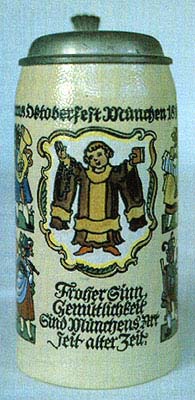
by Jack G. Lowenstein
 |
Soon beer drinking became synonymous with the Oktoberfest and vast amounts of beer were consumed by the fest goers. Naturally, the beer was consumed from 1-liter “Masskruge,” those blue-grey stoneware mugs still in use today at many of Munich's beer cellars. Fried chicken, baked fish and uncountable tons of sausage accompanied the beer. Large white radishes, salted and “weeping,” made certain that the imbibers retained their mighty thirst.
In 1910, the Oktoberfest celebrated its Centennial with much hoopla and a fond look backwards in time. The horse races were brought back and a “Schützenfest” (sharp shooters’ contest) and balloon races kept the crowds entertained — when they weren’t drinking beer, that is. Someone also had the bright idea to issue a “l00th Anniversary” commemorative beer stein, which immediately became a collector’s prize!
Over the ensuing years, other commemorative steins were issued. In 1935, a 125th anniversary stein was brought forth (see picture) and in 1960, the 150th anniversary was celebrated with yet another commemorative. Yes, in 1985, there was a 175th anniversary stein. These commemoratives are always colorfully decorated, usually with the legend, “Münchner Oktoberfest, 1810...” On the base of these steins one finds the stamp, “Offizieller Festkrug Oktoberfest” (Official Octoberfest Festival Stein) and the date. The 1910 Festkrug was designed by Munich artist Franz Ringer and bears his initials.
The steins themselves are made of salt-glazed stoneware, produced in the Westerwald region of Germany in the Rhine River Valley, southeast of Cologne. Salt-glazing was discovered there sometime in the 14th century and in the intervening years was developed into a fine art.
Oktoberfest commemorative steins are much sought after, especially when they were designed by well-known artists such as Ringer. However, there are many reproductions in the marketplace. The serious collector should, therefore, look for the “Offizieller Festkrug” stamp on the stein’s base.
A final comment: Did Ludwig and Therese live happily ever after? No, unfortunately they did not. King Ludwig became infatuated with the (in)famous Lola Montez, a beautiful but basically talentless entertainer from Ireland — after he saw her dance in Munich in 1846. Her consequent intrusion into the king’s life and, indeed into matters of state, forced Ludwig I to abdicate in 1848 in favor of his son, Maximillian II (father of the “dream king,” Ludwig II). But the citizens of Munich and Bavaria soon forgot the sordid affair and happily continue to celebrate the annual Octoberfest to this very day!
__________
*Reprinted by permission from All About Beer Magazine, Vol. 12, No. 2, April/May 1991.